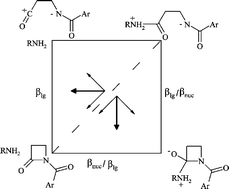The aminolysis of N-aroyl β-lactams occurs by a concerted mechanism
Abstract
N-Aroyl β-lactams are

* Corresponding authors
a
Department of Chemical and Biological Sciences, The University of Huddersfield, Queensgate, Huddersfield, UK
E-mail:
m.i.page@hud.ac.uk
Fax: + 44 (0) 1484 473075
Tel: + 44 (0) 1484 472531
N-Aroyl β-lactams are

 Please wait while we load your content...
Something went wrong. Try again?
Please wait while we load your content...
Something went wrong. Try again?
W. Y. Tsang, N. Ahmed and M. I. Page, Org. Biomol. Chem., 2007, 5, 485 DOI: 10.1039/B616420J
To request permission to reproduce material from this article, please go to the Copyright Clearance Center request page.
If you are an author contributing to an RSC publication, you do not need to request permission provided correct acknowledgement is given.
If you are the author of this article, you do not need to request permission to reproduce figures and diagrams provided correct acknowledgement is given. If you want to reproduce the whole article in a third-party publication (excluding your thesis/dissertation for which permission is not required) please go to the Copyright Clearance Center request page.
Read more about how to correctly acknowledge RSC content.
 Fetching data from CrossRef.
Fetching data from CrossRef.
This may take some time to load.
Loading related content
